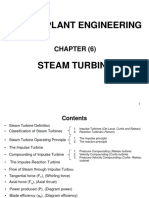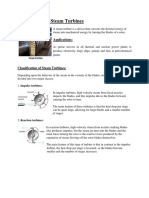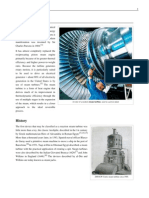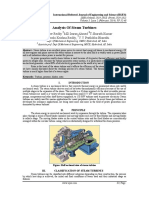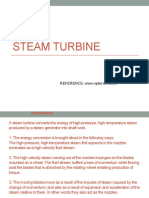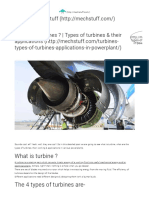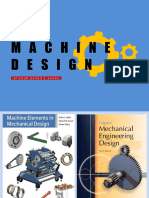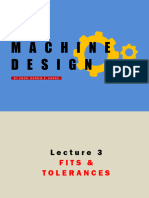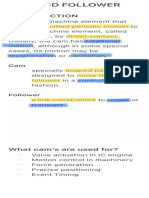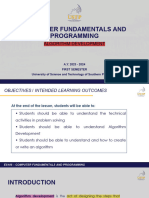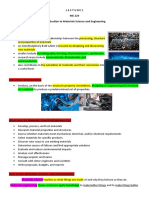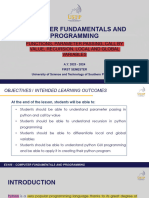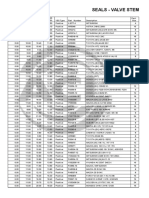Steam Turbine Lecture Notes
Uploaded by
ILEENVIRUSCopyright:
Available Formats
Steam Turbine Lecture Notes
Uploaded by
ILEENVIRUSOriginal Title
Copyright
Available Formats
Share this document
Did you find this document useful?
Is this content inappropriate?
Copyright:
Available Formats
Steam Turbine Lecture Notes
Uploaded by
ILEENVIRUSCopyright:
Available Formats
الجامعة المستنصرية – كلية الھندسة
قســــم الھندســــــــة الميكـــــانيكيـــة
محطــــــــــــات طاقــــــــــــــــــــــة
)CHAPTER (4
Steam Turbine
أ.م.د .مشعل عبد االمير
10‐Dec‐14
Power Plant Engineering الجامعة المستنصرية – كلية الھندسة
Steam Turbine قسم الميكانيك – محطات طــــــــاقة
CHAPTER (4) STEAM TURBINE
The steam turbine is a power unit which produces power. It operates by
converting the thermal energy of a continuous supply of steam into kinetic
energy and then into mechanical energy, the steam being delivered to the
turbine at a high pressure and exhausted to the condenser at a low pressure.
CLASSIFICATION OF STEAM TURBINES: Steam turbines are
generally classified into two groups:-
1. Impulse Turbines (De-Laval, Curtis and Rateau): In impulse
turbines, steam expands in stationary nozzle to attain a high velocity and
then flows over the moving blades, converting some of its kinetic energy
into mechanical work.
2. Reaction Turbines (Parson): In reaction turbines, steam expands both
in stationary nozzle and moving blades.
In general, power generation steam turbines always have both impulse as
well as reaction sections. Steam turbines have many stages, each consist
of one row of stationary nozzles, and one row of moving curved blades.
The impulse principle: If high velocity steam is blown to a curved blade,
then the steam direction will be changed, as shown in figure (1). Hence, the
steam will impart a force (F) on the blade in the direction shown. If the blade
is free, it will move in the direction of force. If a number of blades were
attached on the circumference of a disc which is free to rotate around a shaft,
then, the steam jet will rotate the disc and shaft. In the impulse turbine, the
steam pressure will drop only across the nozzles.
∙
Newton’s 2nd law ⇒ ∑
64 Created by: Assistant Professor Dr. Mishaal AbdulAmeer AbdulKareem
مشعل عبد االمير عبد الكريم.د.م.أ
dr.mishal04@gmail.com
Power Plant Engineering الجامعة المستنصرية – كلية الھندسة
Steam Turbine قسم الميكانيك – محطات طــــــــاقة
Continuous power can be produced only if a series of blades were attached on
the circumference of a turbine wheel, such that the steam jet is inclined to the
blade at an angle (α), so that as the wheel rotates, the blades will continually
face the jet, as shown in figure (2).
Figure (2) Top view of a raw of impulse blade on wheel
The reaction principle: A high pressure steam is passed through nozzles, as
shown in figure (3). When steam comes out from these nozzles, its velocity
increases relative to the rotating disc.
In practice, we hardly find any pure reaction turbine. The common type is
Impulse-Reaction turbine known as “Reaction Turbine”.
In reaction turbine, the pressure drop occurs in both the stationary and moving
blades.
Figure (3) Reaction principle
65 Created by: Assistant Professor Dr. Mishaal AbdulAmeer AbdulKareem
مشعل عبد االمير عبد الكريم.د.م.أ
dr.mishal04@gmail.com
Power Plant Engineering الجامعة المستنصرية – كلية الھندسة
Steam Turbine قسم الميكانيك – محطات طــــــــاقة
The Impulse Turbine:
Figure (4) Flow through impulse blades
The simplest type of impulse turbine is the “De-Laval” turbine, as shown in
figure (4).
It consists of only one set of nozzles, through which, the complete expansion
from chest pressure (≅ boiler pressure) to condenser pressure takes place.
Due to the very large ratio of expansion, the steam leaves the nozzles at a very
high velocity, which would produce a very high rotational speed.
The carry-over losses is also very high.
Compounding of Impulse Turbine: This method is used to reduce the
rotational speed of the impulse turbine. It is done by making use of more than
one set of nozzle-blades, keyed to one common shaft.
There are three types of compounding:-
1. Pressure Compounding (Rateau turbine):
2. Velocity Compounding (Curtis turbine):
3. Pressure-Velocity Compounding:
1. Pressure Compounding (Rateau turbine): In this turbine, the
compounding is done by arranging the expansion of steam in a number of
steps. Each step is called a “Stage” of the turbine, which consists of one
set of nozzles and one row of blades, as shown in figure (5). The expansion
of steam takes place only in the nozzles. Pressure drop per stage is reduced,
and the steam velocity leaving the nozzle is reduced. Thus, the shaft speed
is reduced and the carry-over losses is reduced also.
66 Created by: Assistant Professor Dr. Mishaal AbdulAmeer AbdulKareem
مشعل عبد االمير عبد الكريم.د.م.أ
dr.mishal04@gmail.com
Power Plant Engineering الجامعة المستنصرية – كلية الھندسة
Steam Turbine قسم الميكانيك – محطات طــــــــاقة
Figure (5) Pressure-Compounded Impulse Turbine (Rateau turbine).
2. Velocity Compounding (Curtis turbine):
Figure (6) Velocity-Compounded Impulse Turbine (Curtis turbine).
67 Created by: Assistant Professor Dr. Mishaal AbdulAmeer AbdulKareem
مشعل عبد االمير عبد الكريم.د.م.أ
dr.mishal04@gmail.com
Power Plant Engineering الجامعة المستنصرية – كلية الھندسة
Steam Turbine قسم الميكانيك – محطات طــــــــاقة
This turbine consists a set of nozzles and rows of moving blades fixed to the
rotor, and rows of fixed blades attached to the casing, as shown in figure (6).
The entire expansion takes place in the nozzles. The first row of moving
blades reduce the high velocity of steam partially. The fixed blades redirect
the steam back to the direction of motion and so on to the second moving
blades. By this method, the high rotor speed is reduced.
3. Pressure-Velocity Compounding(Curtis-Rateau turbine):
This type of turbine is a combination of pressure and velocity compounding,
as shown in figure (7). The steam is partially expanded in a row of nozzles
and then enters the rows of velocity compounding, then the steam enters a
second row of nozzles followed by another rows of velocity compounding and
so on.
Figure (7) Pressure-Velocity Figure (8) Impulse-Reaction Turbine.
Compounding Impulse Turbine
(Curtis-Rateau turbine).
The Impulse-Reaction Turbine: The reaction turbine applies the principle
of both; the pure impulse and the pure reaction turbine. Each stage of the
reaction turbine consist of a fixed row of blades (nozzles) over the whole of
the circumferential annulus, and an equal number of moving blades attached
to a wheel. Admission of steam takes place over the complete annulus, and so
there is “full admission” with a small drop in pressure and an increase in
velocity. The steam then passes over the first row of moving blades. This will
change the steam direction and its momentum. This gives an impulse force to
the blades. There is a further drop in pressure as the steam passes through the
moving blades (nozzles). Therefore, there is an increase in the steam velocity
relative to the blades, which gives reaction force in the direction opposite to
rotation. Thus, the driving force is the sum of both impulse and reaction
forces, as shown in figure (8).
68 Created by: Assistant Professor Dr. Mishaal AbdulAmeer AbdulKareem
مشعل عبد االمير عبد الكريم.د.م.أ
dr.mishal04@gmail.com
Power Plant Engineering الجامعة المستنصرية – كلية الھندسة
Steam Turbine قسم الميكانيك – محطات طــــــــاقة
FLOW OF STEAM THROUGH IMPULSE TURBINE:
Notation:
V1 = Absolute velocity of steam at blade inlet
V2 = Absolute velocity of steam at blade outlet
Vr1 = Relative velocity of steam at blade inlet
Vr2 = Relative velocity of steam at blade outlet
U = Mean blade speed
α1 = Nozzle angle
α2 = Absolute steam angle at blade outlet
β1 and β2 = Blade angles at inlet and outlet
Vw1 and Vw2= Tangential (whirl) component of absolute velocity at blade
inlet and outlet
Vf1 and Vf2= Axial component of absolute velocity at blade inlet and outlet
FT = Tangential force (whirling force)
Fa = Axial force (Axial thrust)
(for symmetric blades) => β1 = β2
(for frictional flow) => Vr2= k Vr1 (k=blade velocity coefficient)
Tangential force (FT), (Whirling force):
∙ ∙
∙
∴ , (N)
69 Created by: Assistant Professor Dr. Mishaal AbdulAmeer AbdulKareem
مشعل عبد االمير عبد الكريم.د.م.أ
dr.mishal04@gmail.com
Power Plant Engineering الجامعة المستنصرية – كلية الھندسة
Steam Turbine قسم الميكانيك – محطات طــــــــاقة
Axial force (Fa), (Axial thrust):
∙
∙
, (N)
Power produced (P), (Diagram power):
∙
∴ , (Watt)
Blade efficiency (b), (Diagram efficiency):
It is the ratio of the power produced by the blade to the jet power entering
the blade.
∙
1 ∙
2
2
∴
Example (1):
The velocity of steam leaving the nozzles of an impulse turbine is (900 m/s)
and the nozzle angle is (20o). The blade velocity is (300 m/s) and the blade
velocity coefficient is (0.7). For a steam mass flow of (1 kg/s), and
symmetrical blading. Calculate the following:
a) The blade inlet angle 1
b) The driving force on the wheel (FT)
c) The axial thrust (Fa)
d) The diagram power (P)
e) The diagram efficiency
70 Created by: Assistant Professor Dr. Mishaal AbdulAmeer AbdulKareem
مشعل عبد االمير عبد الكريم.د.م.أ
dr.mishal04@gmail.com
Power Plant Engineering الجامعة المستنصرية – كلية الھندسة
Steam Turbine قسم الميكانيك – محطات طــــــــاقة
Solution:
900
20
300
0.7
∆ :
2
900 300 2 900 300 20
∴ 626.5 /
∆ :
∡
∡ 180
900 20
∴
626.5
∴ 29 24 (Symmetrical blade)
0.7 626.5 438.5 /
1.7
1.7 626.5 29 24
∴ 927.7 /
∙
1 927.7 927.7
71 Created by: Assistant Professor Dr. Mishaal AbdulAmeer AbdulKareem
مشعل عبد االمير عبد الكريم.د.م.أ
dr.mishal04@gmail.com
Power Plant Engineering الجامعة المستنصرية – كلية الھندسة
Steam Turbine قسم الميكانيك – محطات طــــــــاقة
0.3
0.3 626.5 29 24
∴ 92.3 /
∙
1 92.3 92.3
∙
1 927.7 300
278.3
10
2 2 300 927.7
∴ 0.687
900
∴ 68.7%
HOME WORK:
Prove that the optimum blade speed ratio for maximum blade efficiency:
: 4
STAGE EFFICIENCY (s):
It is the ratio of the work done on blade, per
(1 kg) of steam flowing through the blades,
to the isentropic heat drop in the stage, per (1
kg) of steam.
Δ
Δ Δ
Multiply the above equation by , we
get:-
2
2Δ
∴
∙
Nozzle efficiency => ∙
72 Created by: Assistant Professor Dr. Mishaal AbdulAmeer AbdulKareem
مشعل عبد االمير عبد الكريم.د.م.أ
dr.mishal04@gmail.com
Power Plant Engineering الجامعة المستنصرية – كلية الھندسة
Steam Turbine قسم الميكانيك – محطات طــــــــاقة
DEGREE OF REACTION (R):
In reaction turbine, the degree of reaction is defined as the ratio of the heat
drop in moving blades to heat drop in stage (fixed blades+ moving blades), as
shown in figure (9).
∆ ∆
∆ ∆ ∆
Figure (9) Enthalpy drop in a reaction stage
Parson Turbine => 50%
COMULATIVE HEAT DROP (hc):
It is the sum of the isentropic heat drop of the stage;
∆ ∆
Figure (10) Condition line for a Multi-stage steam turbine
REHEAT FACTOR (RF >1):
It is the ratio of the cumulative heat drop ∆ to the direct heat drop
∆ →
∑ ∆
∆ →
73 Created by: Assistant Professor Dr. Mishaal AbdulAmeer AbdulKareem
مشعل عبد االمير عبد الكريم.د.م.أ
dr.mishal04@gmail.com
Power Plant Engineering الجامعة المستنصرية – كلية الھندسة
Steam Turbine قسم الميكانيك – محطات طــــــــاقة
OVERALL EFFICIENCY (o):
It is the ratio of the internal work ∑ Δ in the turbine to the direct heat
drop ∆ → .
∑Δ
∆ →
∴
If the stage efficiency is equal for all stages of the turbine, then;
⋯
∑Δ
⇒ Δ ∆
∆
Δ ∆ →
Also;
Example (2):
Steam at (15 bar, 350 Co) is expanded through a (50%) reaction turbine to a
pressure of (0.14 bar). The stage efficiency is (75%) for each stage, and the
reheat factor is (1.04). The expansion is to be
carried out in (20) stages, and the diagram
power is (12 MW). Calculate the required
flow of steam, assuming that all the stages
develop equal work.
Solution:
From (h-s) chart:
@ 15 , 350
⇒ 3148 /
@ 0.14
⇒ 2293 /
0.75 1.04 0.78
∆
⟹∆ ∆ 0.78 3148 2293 667 /
∆
∆ 0.78 3148 2293 667 /
∙ ∙
12 10
∆ ⟹ 17.99
∆ 667
74 Created by: Assistant Professor Dr. Mishaal AbdulAmeer AbdulKareem
مشعل عبد االمير عبد الكريم.د.م.أ
dr.mishal04@gmail.com
Power Plant Engineering الجامعة المستنصرية – كلية الھندسة
Steam Turbine قسم الميكانيك – محطات طــــــــاقة
LOSSES IN STEAM TURBINES:
Figure (11) Stepped labyrinth seals
TURBINE GOVERNING AND CONTROL: The purpose of governing is to
maintain a constant turbine speed irrespective of turbine load. The methods of governing
used are:-
1. Throttle governing: In this method, as shown in figure (12), the steam mass flow
rate is reduced whenever there is a reduction of load by decreasing the inlet pressure, the
enthalpy remains constant and the available energy is reduced. This reduces the efficiency
of turbine. When the steam consumption is plotted against the turbine load, it shows a linear
relationship. This graph is called the “Willan’s line”, as shown in figure (13).
∙ ∙
∙
Steam consumption at zero power output, (ton,hr)
∙
Steam consumption, (ton,hr)
Constant
Power output, (MW)
75 Created by: Assistant Professor Dr. Mishaal AbdulAmeer AbdulKareem
مشعل عبد االمير عبد الكريم.د.م.أ
dr.mishal04@gmail.com
Power Plant Engineering الجامعة المستنصرية – كلية الھندسة
Steam Turbine قسم الميكانيك – محطات طــــــــاقة
Figure (12) Throttle governing Figure (13) Willan’s line
Figure (14) Nozzle governing Figure (15) By-pass governing
2. Nozzle governing: In this method, the steam mass flow rate is reduced by
reducing the area available to the steam jet with constant inlet pressure. This method
involves the use of several valves instead of one. Each valve control the admission of steam
to a group of nozzles, which are made up in sets, the sets need not consist of equal number
of nozzles, but are arranged to give the required degree of control. When a load lower than
the design value is supplied to the turbine, the required number of nozzles can be shut off
from the steam supply, and the rest will continue to receive steam at the supply pressure,
as shown in figure (14).
3. By-pass governing: With turbines designed to work at economic load, it is
desirable to have full-admission of steam in the high-pressure stages. At the maximum
load, which is greater than the economic load, the required additional steam could not pass
through the first stage since additional nozzles are not available. By-pass regulation allow
for this in a turbine which is throttle governed, by means of a second valve in the first stage
nozzle chest, as shown in figure (15).
76 Created by: Assistant Professor Dr. Mishaal AbdulAmeer AbdulKareem
مشعل عبد االمير عبد الكريم.د.م.أ
dr.mishal04@gmail.com
Power Plant Engineering TUTORIAL SHEET ‐ 4 الجامعة المستنصرية – كلية الھندسة
Steam Turbine قسم الميكانيك – محطات طــــــــاقة
1‐ The velocity of steam at inlet to a simple impulse turbine is (1000 m/s), and the nozzle angle
is (20 o). The blade speed is (400 m/s), and the blades are symmetrical. Determine the blades
angle if the steam is to enter without shock. If the friction effects on the blade are negligible,
calculate the tangential force on the blades and the diagram power for a mass flow of (0.75
kg/s). What is the axial thrust and the diagram efficiency?
If the relative velocity at exit is reduced by friction to (80 %) of that at inlet, what is then the
diagram power and the axial thrust?
Calculate also the diagram efficiency in this case.
(Ans. 32.5; 810 N; 324 kW; 0; 86.2%; 291.5 kW; 51.29 N; 77.7%)
2‐ The steam from the nozzles of a single wheel impulse turbine discharges with a velocity of
(600 m/s) and at (20 o) to the plane of the wheel. The blade wheel rotates at (3000 rpm) and
the mean blade radius is (590 mm). The axial velocity of the steam at exit from the blades is
(164 m/s) and the blades are symmetrical. Calculate:
a) The blade angles,
b) The diagram work per (1 kg/s) steam flow,
c) The diagram efficiency,
d) The blade velocity coefficient.
(Ans. 28o28’; 126.3 kj per kg/s; 70%; 0.799)
3‐ A reaction turbine is supplied with steam at (60 bar, 600 Co). The condenser pressure is (0.07
bar). If the reheat factor can be assumed to be (1.04) and the stage efficiency is constant
throughout at (80%). Calculate the steam flow required in (ton/hr) for a diagram power of
(25 MW). (Ans. 75.6 ton/hr)
4‐ The steam consumption at full load for a (3 MW) turbine is (16.6 ton/hr). At half load the
steam consumption is (9.1 ton/hr). Applying Willan’s line, estimate the steam consumption
at no load, and the consumption at a load of (2.5 MW).
(Ans. 1.6 ton/hr; 14.1 ton/hr)
5‐ A single‐stage impulse turbine is required to develop (50 MW) of power. Steam enters the
nozzles saturated at (70 bar), and leaves at (50 bar). The blades are symmetrical and have a
velocity coefficient of (0.96). calculate:
(a) The minimum steam flow in (kg/s) that would result in the required power,
(b) The blade efficiency,
(c) The stage efficiency.
77 Created by: Assistant Professor Dr. Mishaal AbdulAmeer AbdulKareem
مشعل عبد االمير عبد الكريم.د.م.أ
dr.mishal04@gmail.com
You might also like
- Marine Motor Notes Edition 2017 by Rajesh Singh Gulia90% (10)Marine Motor Notes Edition 2017 by Rajesh Singh Gulia350 pages
- 1966 - Jachens - Steam Turbines Their Construction100% (1)1966 - Jachens - Steam Turbines Their Construction19 pages
- Types and Working Principles Steam TurbinesNo ratings yetTypes and Working Principles Steam Turbines116 pages
- Types and Working Principles Steam Turbines100% (4)Types and Working Principles Steam Turbines69 pages
- Introduction To Steam Turbines: ApplicationsNo ratings yetIntroduction To Steam Turbines: Applications3 pages
- 16.8.22 An-Introduction To Steam TurbineNo ratings yet16.8.22 An-Introduction To Steam Turbine10 pages
- Steam Turbines.: The Energy Conversion Process100% (1)Steam Turbines.: The Energy Conversion Process9 pages
- SVU42644984-6276-Applied_ThermodynamicsNo ratings yetSVU42644984-6276-Applied_Thermodynamics18 pages
- Design and Thermal Analysis of Steam Turbine Blade Using Fem MethodNo ratings yetDesign and Thermal Analysis of Steam Turbine Blade Using Fem Method11 pages
- Power Plant Lecture Notes - CHAPTER-4 STEAM TURBINE: October 2014No ratings yetPower Plant Lecture Notes - CHAPTER-4 STEAM TURBINE: October 201442 pages
- '' Turbine - Nozzle - Diffuser - Compressor ''100% (1)'' Turbine - Nozzle - Diffuser - Compressor ''15 pages
- Steam Turbine Electricity Generation Plants: Aeolipile, A ReactionNo ratings yetSteam Turbine Electricity Generation Plants: Aeolipile, A Reaction10 pages
- Steam Turbine: REFERENCE: WWW - Nptel.iitm - Ac.in100% (1)Steam Turbine: REFERENCE: WWW - Nptel.iitm - Ac.in21 pages
- What Are Turbines - Types of Turbines & Their Applications - MechStuffNo ratings yetWhat Are Turbines - Types of Turbines & Their Applications - MechStuff7 pages
- Power Plant Lecture Notes - CHAPTER-3 STEAM GENERATOR: October 2014No ratings yetPower Plant Lecture Notes - CHAPTER-3 STEAM GENERATOR: October 201446 pages
- Compounding of Steam Turbine Lecture Sli PDF100% (1)Compounding of Steam Turbine Lecture Sli PDF13 pages
- ARIJIT SAHA_THERMAL POWER ENGINEERING_compressedNo ratings yetARIJIT SAHA_THERMAL POWER ENGINEERING_compressed10 pages
- Important Short Questions DYNAMICS AND DESIGN OF MACHINERYNo ratings yetImportant Short Questions DYNAMICS AND DESIGN OF MACHINERY32 pages
- Study and Explain Different Types of Turbines and Their Applications in Various Field75% (8)Study and Explain Different Types of Turbines and Their Applications in Various Field22 pages
- Some Power Electronics Case Studies Using Matlab Simpowersystem BlocksetFrom EverandSome Power Electronics Case Studies Using Matlab Simpowersystem BlocksetNo ratings yet
- Influence of System Parameters Using Fuse Protection of Regenerative DC DrivesFrom EverandInfluence of System Parameters Using Fuse Protection of Regenerative DC DrivesNo ratings yet
- Simulation of Some Power Electronics Case Studies in Matlab Simpowersystem BlocksetFrom EverandSimulation of Some Power Electronics Case Studies in Matlab Simpowersystem BlocksetNo ratings yet
- Simulation of Some Power Electronics Case Studies in Matlab Simpowersystem BlocksetFrom EverandSimulation of Some Power Electronics Case Studies in Matlab Simpowersystem BlocksetNo ratings yet
- Me414 Lecture 1 Analysis of Simple StressesNo ratings yetMe414 Lecture 1 Analysis of Simple Stresses19 pages
- Topic 4 Fuels and Combustion Sample ProblemsNo ratings yetTopic 4 Fuels and Combustion Sample Problems25 pages
- Module - 5 - Python - Algorithm DevelopmentNo ratings yetModule - 5 - Python - Algorithm Development35 pages
- Lecture 9 Engg. Economy Comparing AlternativesNo ratings yetLecture 9 Engg. Economy Comparing Alternatives13 pages
- Simulation and Study of Shell and Tube Type Heat ENo ratings yetSimulation and Study of Shell and Tube Type Heat E9 pages
- ESC 18 - Dynamics of Rigid Bodies Seat Work No. 2No ratings yetESC 18 - Dynamics of Rigid Bodies Seat Work No. 23 pages
- 1104D 1106D Electrical Electronic Installation Guide Jan 2007100% (1)1104D 1106D Electrical Electronic Installation Guide Jan 2007119 pages
- C-15 Truck Engine 9NZ00001-UP (SEBP3032 - 125) - Install InjectorNo ratings yetC-15 Truck Engine 9NZ00001-UP (SEBP3032 - 125) - Install Injector6 pages
- J1939-Modbus Procon With Diagnostic Trouble Codes Canadian Automotive Instruments LTDNo ratings yetJ1939-Modbus Procon With Diagnostic Trouble Codes Canadian Automotive Instruments LTD3 pages
- CAM2 Magnum Turbo D 15W-40 Product BulletinNo ratings yetCAM2 Magnum Turbo D 15W-40 Product Bulletin2 pages
- Appendix2 Hand Tools Final - Wartsila 16/20V34SG100% (1)Appendix2 Hand Tools Final - Wartsila 16/20V34SG2 pages
- Aprilia RSV Mille Technical Training Course100% (63)Aprilia RSV Mille Technical Training Course9 pages
- Marine Motor Notes Edition 2017 by Rajesh Singh GuliaMarine Motor Notes Edition 2017 by Rajesh Singh Gulia
- 1966 - Jachens - Steam Turbines Their Construction1966 - Jachens - Steam Turbines Their Construction
- Design and Thermal Analysis of Steam Turbine Blade Using Fem MethodDesign and Thermal Analysis of Steam Turbine Blade Using Fem Method
- Power Plant Lecture Notes - CHAPTER-4 STEAM TURBINE: October 2014Power Plant Lecture Notes - CHAPTER-4 STEAM TURBINE: October 2014
- Steam Turbine Electricity Generation Plants: Aeolipile, A ReactionSteam Turbine Electricity Generation Plants: Aeolipile, A Reaction
- Steam Turbine: REFERENCE: WWW - Nptel.iitm - Ac.inSteam Turbine: REFERENCE: WWW - Nptel.iitm - Ac.in
- What Are Turbines - Types of Turbines & Their Applications - MechStuffWhat Are Turbines - Types of Turbines & Their Applications - MechStuff
- Power Plant Lecture Notes - CHAPTER-3 STEAM GENERATOR: October 2014Power Plant Lecture Notes - CHAPTER-3 STEAM GENERATOR: October 2014
- Important Short Questions DYNAMICS AND DESIGN OF MACHINERYImportant Short Questions DYNAMICS AND DESIGN OF MACHINERY
- Study and Explain Different Types of Turbines and Their Applications in Various FieldStudy and Explain Different Types of Turbines and Their Applications in Various Field
- Scientific American Supplement, No. 633, February 18, 1888From EverandScientific American Supplement, No. 633, February 18, 1888
- Some Power Electronics Case Studies Using Matlab Simpowersystem BlocksetFrom EverandSome Power Electronics Case Studies Using Matlab Simpowersystem Blockset
- Influence of System Parameters Using Fuse Protection of Regenerative DC DrivesFrom EverandInfluence of System Parameters Using Fuse Protection of Regenerative DC Drives
- Simulation of Some Power Electronics Case Studies in Matlab Simpowersystem BlocksetFrom EverandSimulation of Some Power Electronics Case Studies in Matlab Simpowersystem Blockset
- Simulation of Some Power Electronics Case Studies in Matlab Simpowersystem BlocksetFrom EverandSimulation of Some Power Electronics Case Studies in Matlab Simpowersystem Blockset
- Simulation and Study of Shell and Tube Type Heat ESimulation and Study of Shell and Tube Type Heat E
- 1104D 1106D Electrical Electronic Installation Guide Jan 20071104D 1106D Electrical Electronic Installation Guide Jan 2007
- C-15 Truck Engine 9NZ00001-UP (SEBP3032 - 125) - Install InjectorC-15 Truck Engine 9NZ00001-UP (SEBP3032 - 125) - Install Injector
- J1939-Modbus Procon With Diagnostic Trouble Codes Canadian Automotive Instruments LTDJ1939-Modbus Procon With Diagnostic Trouble Codes Canadian Automotive Instruments LTD



